Omer On Location: Jewish History in Prague, the Czech Republic
Jewish Federation's Israeli Emissary, Omer Karavani, Reflects on a Recent Trip
Hello everyone! Hope you are all doing well. As some of you know, I just came back from a trip to Israel to visit my family, but this article is talking about a different chapter in Jewish history in Prague, the Czech Republic.
I went with my family to visit Prague as part of a vacation and found a great story of Jewish history that I am happy to present to you, maybe for your next vacation to Europe!
In the center of Prague is a small but very special area called the Jewish Quarter, or Josefov. It got its name in the 1800s after Emperor Joseph II, who made life better for Jews in the Austro-Hungarian Empire by giving them more rights. But the history of Jews in Prague goes back much further.
Walking through the Jewish Quarter today, it’s hard to believe how much it has survived. Six beautiful synagogues, old buildings, and narrow streets still stand and tell the story of a proud and ancient community. One of the questions I asked myself while walking in those streets is why was Prague not destroyed in World War II?
So, I looked it up and discovered that one of the most surprising things about Prague is that it wasn’t destroyed during World War II. While cities like Warsaw and Berlin were bombed and burned, Prague was mostly left untouched.
There are a few reasons for this. First, when the Nazis took over Czechoslovakia in 1939, they faced no resistance—so there were no battles in the streets of Prague.
Second, Hitler loved the way Prague looked. He saw it as a perfect example of European architecture and wanted to keep it as part of his vision for the Nazi empire.
But maybe the most shocking reason is this: Hitler planned to turn Prague’s Jewish Quarter into a “museum of an extinct race.” He wanted to destroy the Jewish people—but keep their buildings and items on display. That’s why many synagogues and Jewish artifacts were saved—so they could become part of a twisted museum after the Holocaust.
There was only one bombing mistake during the war. In February 1945, U.S. planes accidentally dropped bombs on parts of Prague. They thought they were over Dresden, Germany. Some people died and buildings were damaged, but the Jewish Quarter was not hit.
The Spanish Synagogue
One of the most beautiful buildings in the Jewish Quarter is the Spanish Synagogue. Even though it’s called “Spanish,” it wasn’t built by Sephardic Jews. It got the name because of its Moorish-style design—inspired by the synagogues of Spain.
The inside is stunning, with colorful walls, gold decorations, and big arches. Today, it’s not used for regular prayer but serves as a museum and concert hall. It tells the story of Jews in Prague from the 18th century until today.
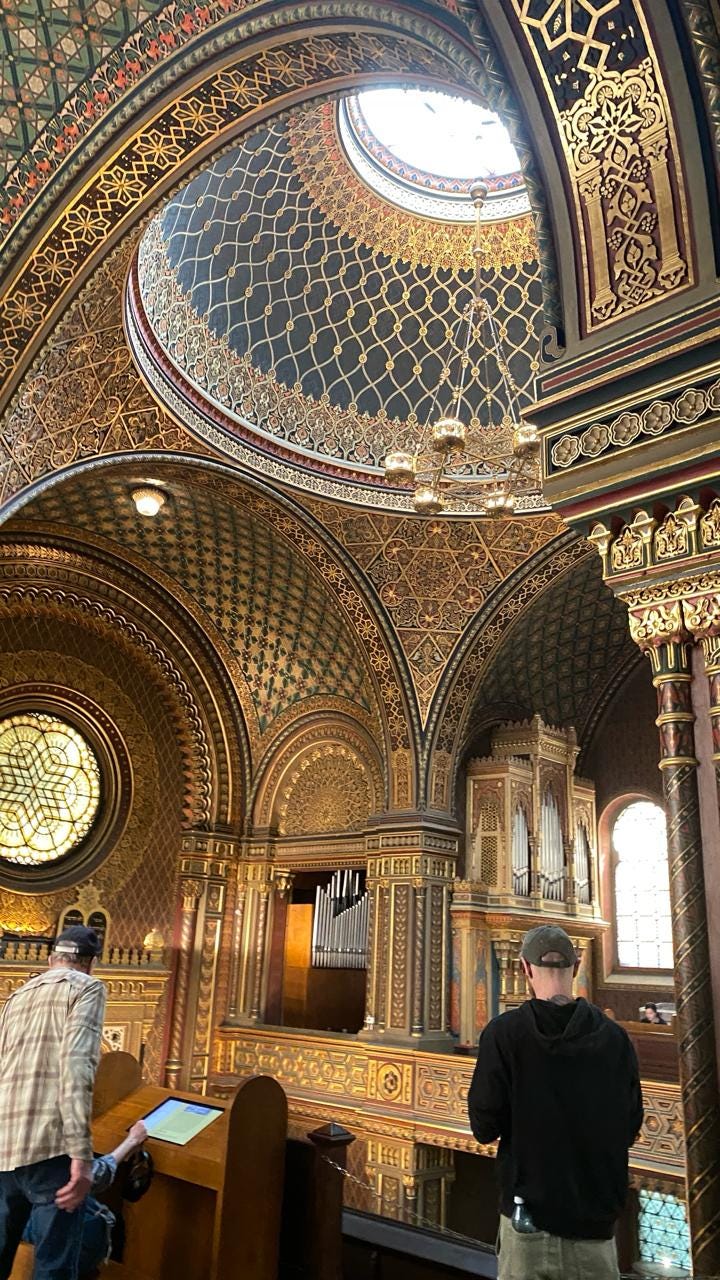
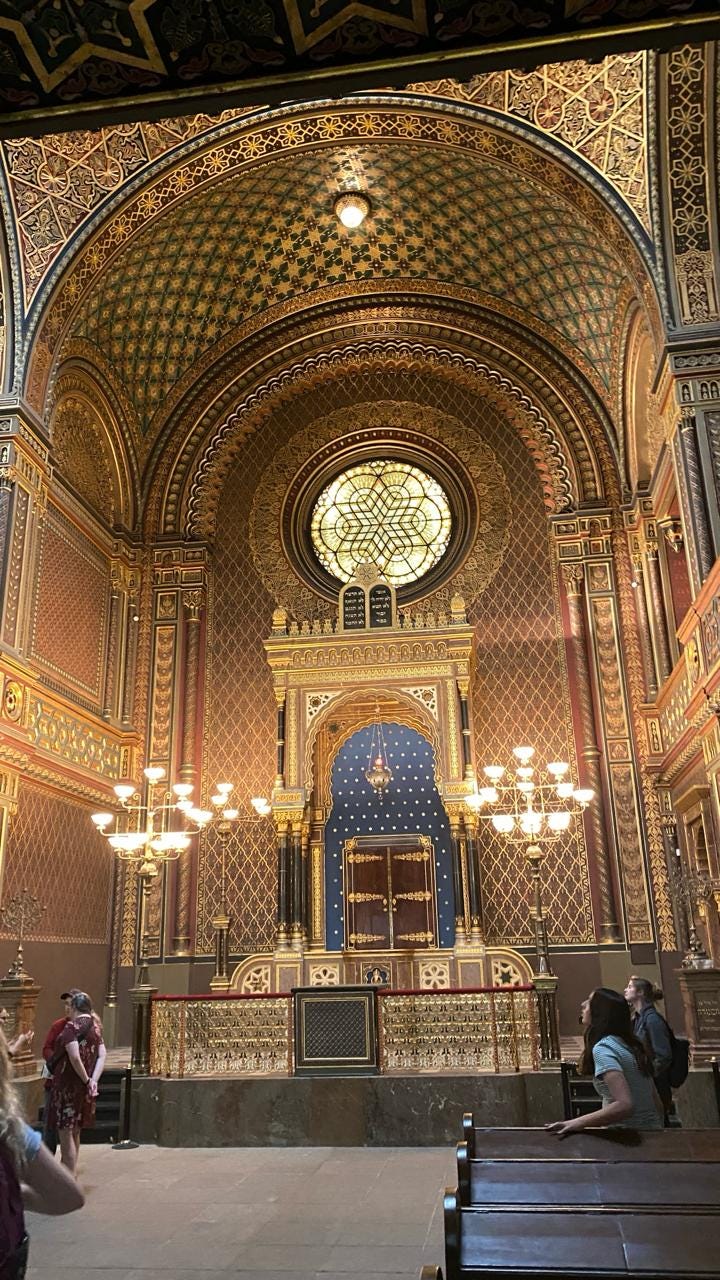
Pinkas Synagogue
Established in 1479 and located in front of the entrance to the old Jewish Cemetery, the Pinkas Synagogue is the second-oldest Jewish synagogue still standing in Prague and one of the most renowned. After the end of World War II, the synagogue was turned into a memorial for the 77,297 Jews from Czechoslovakia killed during the Holocaust. Inside, its walls are covered with all their names.

The Old Jewish Cemetery
Right behind the synagogues is one of the oldest Jewish cemeteries in Europe: The Old Jewish Cemetery, used from the 1400s until the 1700s. Because Jews were not allowed to bury outside their quarter, they had to stack graves on top of each other—as many as 12 layers deep. Walking through the cemetery, you see thousands of crooked, old stones, each with Hebrew writing. One of the most famous graves here is that of Rabbi Judah Loew ben Bezalel, also known as the Maharal of Prague.
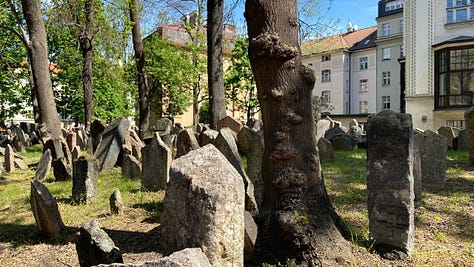
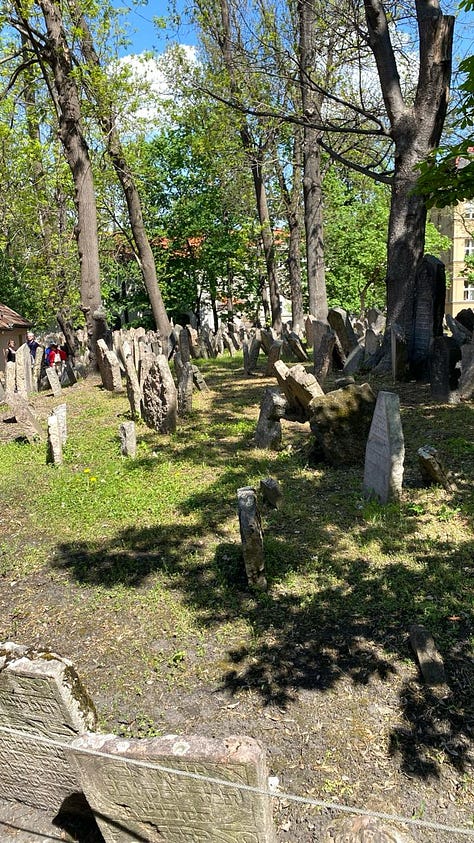
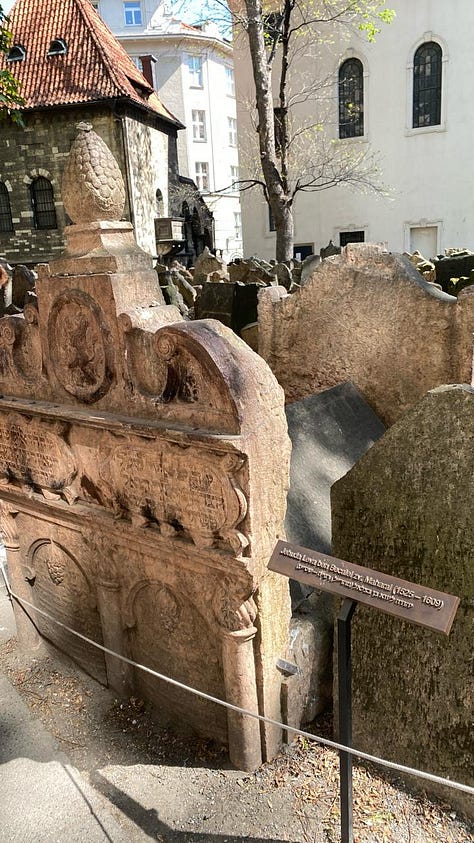
The Maharal and the Golem
The Maharal was a great rabbi, scholar, and thinker in the 1500s. But he’s also famous for something more mysterious: the legend of the Golem. The story says that the Maharal created a Golem—a creature made of clay—to protect the Jewish community from danger. He brought it to life using holy words and placed it in the attic of the Old New Synagogue, where some say it still rests.
Even today, the story of the Golem is a big part of Prague’s folklore. In souvenir shops across the city, you can buy little Golem dolls—a reminder of the mix between history, legend, and hope.

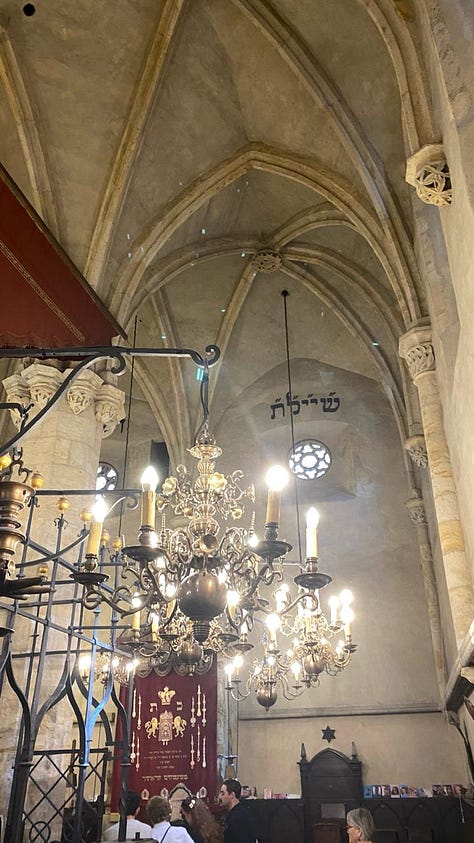

Jewish Food in Prague
After exploring the Jewish Quarter, I was so hungry! While there aren’t many kosher restaurants in Prague, here are a few good spots. King Solomon Restaurant—near the Spanish Synagogue. Kosher and delicious. Chabad’s Dinitz Restaurant. Shelanu Café—a small spot near the Old New Synagogue run by the Jewish community. I tried their pizza, very good!
And if you want something sweet, don’t miss the Trdelník (chimney cake.) Now, I will say this. Even though the Trdelník (chimney cake) is very good, and a lot of people think that this cake was crafted first in Prague, which is not true. Its origin is Hungary—and the name is Kürtős (now technically it is Transylvania, Romania—yes, the birthplace of a vampire’s folklore, but that’s a different story.) But this area used to belong to the Austro-Hungarian Empire, so we will say there is a Hungarian influence on it.
Most versions of the cake have butter or milk, but some shops in the Jewish Quarter sell pareve, kosher-friendly versions—great with cinnamon and sugar. One of the best places is right next to the Jewish Museum.
Conclusion: A Living Story
Prague’s Jewish Quarter is not just a place of history—it’s a place of memory, faith, and survival. Today, Jewish life in Prague continues. It may be smaller, but it’s full of pride and spirit. And anyone who visits can see it, feel it, and even taste it—in every step, every stone, and every bite of chimney cake.
Omer Karavani
Israeli Emissary
Jewish Federation of St. Joseph Valley
israel@thejewishfed.org

